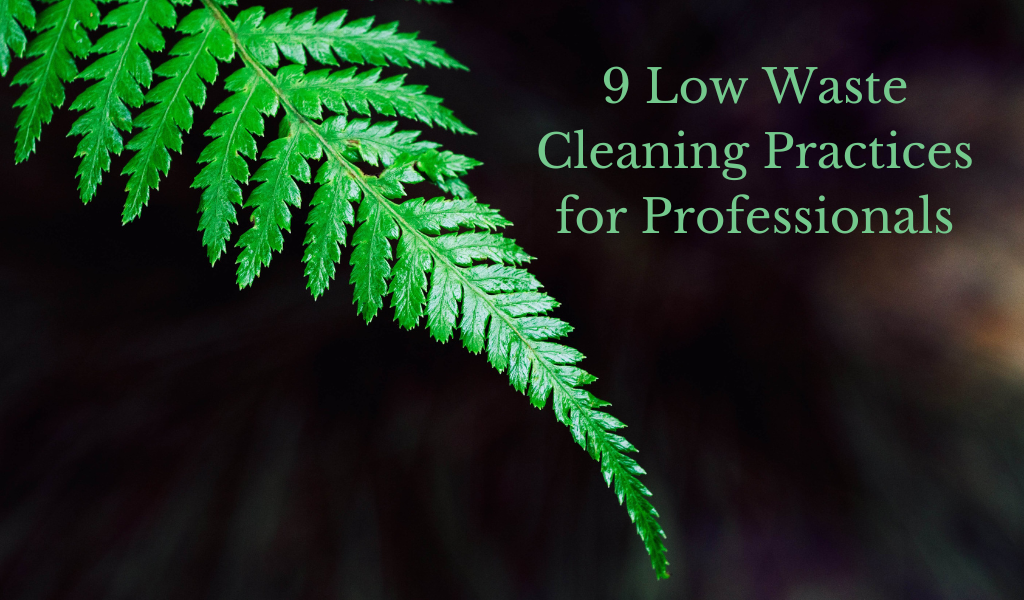Zero waste and low waste cleaning products and practices are popular, profitable, and not as difficult to come by as they might seem.
Look around for zero or low waste cleaning ideas, and you’ll find page after page of products, tips, and practices for cleaning your home. Some of these ideas work well on a small scale, but they just don’t cut it for commercial cleaning. Compostable wipes may be fine when you clean a small bathroom once a week, but things are a little different when you order cleaning supplies by the case.
At the same time, many low waste cleaning practices are also economically sound business practices. Yes, there are benefits to the environment, to the people working with and around these products, and to the general reduction in waste. But even if we set those issues aside, there is still plenty of evidence that suggests making an effort to reduce or even eliminate waste is an excellent business decision.
Harness the value of Janitorial Manager to streamline your cleaning operation like never before. Learn more today with a free discovery call and find out how to make your cleaning operation more efficient and cost effective!
9 Low Waste Cleaning Practices to Save Money and the Environment
1. Regular maintenance. You rely on your commercial cleaning equipment to perform day after day. Without it, you can’t do your job. At least, you can’t do it efficiently. Regular maintenance keeps everything in working order and ready when you need it. Additionally, maintaining your equipment means you’ll notice ahead of time if something is going to need a major repair soon. That’s all good for running your business, but what does it have to do with low-waste cleaning practices? Well-maintained equipment runs more efficiently and lasts longer, reducing overall waste.
2. Efficient client scheduling. If you work in multiple locations, you can save a lot of time and gas (not to mention wear and tear on your vehicles) when you schedule your clients in geographical order. Maybe you begin with the client closest to you and work out so that your last client is the one furthest away. Or perhaps you start at the end and work back toward your office.
3. Buy concentrates. RTU (Ready-to-Use) products have advantages, certainly. But when it comes to low waste cleaning practices, you can’t beat the efficiency of concentrates. You can get more product with less packaging, and shipping is more environmentally friendly since providers can fit more product on a pallet.
4. Properly mix cleaning products. The catch with concentrates vs. RTU products is that you do have to mix them. And you have to mix them correctly. Overdo it, and you’re wasting. Underdo it, and the product won’t work effectively, and you may need to use even more to do the job a second time. To that end, dilution systems can be helpful if your facility is set up for it.
5. Use greener cleaning products. Look for the Safer Choice or DfE (Design for the Environment) labels, both managed by the EPA. While they may not impact you directly, they generally fall in line with zero and low-waste cleaning practices as the manufacturers tend to follow sustainable practices.
6. Manage your inventory. There are so many reasons to track and manage your inventory closely. From a customer service perspective, you want to have the products and equipment you need to do the job. From a cost perspective, you don’t want to get into a situation where you need to pay extra for expedited shipping or buy a more expensive product due to availability. Low waste cleaning isn’t always about products and equipment; it can also be about how efficiently you run your business.
7. Manage your inventory part two. Need some more reasons to manage your inventory? When you order in bulk, you’re saving your own time and energy, saving money on shipping costs, and saving the fuel and emissions that go into those items getting shipped from your supplier. That’s easy enough when everything is in one location, but if you have supplies and equipment stored across multiple facilities, it can get a little complicated. However, using software like Janitorial Manager can help with inventory and supply budgeting, even down to the dollar amount.
8. Switch to microfiber cloths. They last longer. You can wash them and reuse them numerous times. And most of them don’t require as much water to clean.
9. Invest in resource-efficient equipment. This is a more significant project, and it may not feel very much like a low-waste cleaning practice right away. However, when the time comes to purchase new cleaning equipment, look for products that are designed to work as efficiently as possible. These might be mop buckets made from recycled material, or you might be looking at robotic floor cleaners that minimize the amount of water and product needed to do a job.
If you’ve thought about trying to move your commercial cleaning business toward more sustainable practices, it’s a good move, and it’s not as challenging as it might seem. Start small. Every step in the right direction is a step in the right direction!
If you’re ready to bring your cleaning organization to the next level, schedule a free call with Janitorial Manager to see how our software can make your janitorial operation more successful.


